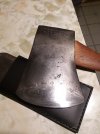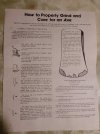I ha e a new Hudson bay style camp axe. it is a convex grind which I'm less familiar with. as such the bevel seems very small to me tiny really. in trying it out granted I was working with some oak and knotty at that but the axe didnt seem to bite the wood deeply at all. the edge feels sharp enough cant quite shave but bites my thumb nail. 'm looking for some guidance. should the bevel in this type of grind look the way it does or should I put a lower angle and thus wider bevel in it. my intended use is general camping prepping firewood and chopping small pots etc. thank you.
-
The BladeForums.com 2024 Traditional Knife is ready to order! See this thread for details: https://www.bladeforums.com/threads/bladeforums-2024-traditional-knife.2003187/
Price is$300$250 ea (shipped within CONUS). If you live outside the US, I will contact you after your order for extra shipping charges.
Order here: https://www.bladeforums.com/help/2024-traditional/ - Order as many as you like, we have plenty.
You are using an out of date browser. It may not display this or other websites correctly.
You should upgrade or use an alternative browser.
You should upgrade or use an alternative browser.
convex grind
- Thread starter amills
- Start date
- Joined
- Mar 31, 2018
- Messages
- 1,875
Convex is ideal. But you don't need a lot of it. I grind (file) my axes from about 2" back to 25° up to about an 1/8th before the cutting edge. At that point you want to roll it off to a convex shape. Often people will do a micro bevel (small flat angle) though convex is better. Here's an example;

And here's an very good, succinct explanation from a manufacturer; (left hand column)

Though you don't have to make it that convex. After all this is a factory brochure and they are recommending what they will warranty. Hope this helps!

And here's an very good, succinct explanation from a manufacturer; (left hand column)

Though you don't have to make it that convex. After all this is a factory brochure and they are recommending what they will warranty. Hope this helps!
Square_peg
Gold Member
- Joined
- Feb 1, 2012
- Messages
- 13,836
Pictures would help.
- Joined
- Mar 10, 2011
- Messages
- 2,678
very helpful. mine is not fanned at all straight from council tools factory. it seems like it is way too thi and is only sharpened an eight from the edge.

https://ibb.co/ypFNvjD
Bob
- Joined
- Mar 31, 2018
- Messages
- 1,875
Yes that could definitely use some filing and honing! I'm surprised it left the factory that way.
It was smart of you to ask first! Most people(that don't know any better) just put the belt sander to it and ask questions later. There's a "what did you sharpen today" thread in the axe and tomahawk forum. Be sure to upload pics either there or here to let us see your progress and your axes improvement!
It was smart of you to ask first! Most people(that don't know any better) just put the belt sander to it and ask questions later. There's a "what did you sharpen today" thread in the axe and tomahawk forum. Be sure to upload pics either there or here to let us see your progress and your axes improvement!
Last edited:
amills,
Carpenter axes have flat edges, forest axes have convex edges. Carpenter axes are used along the wood fibers, forest axes are use across wood fibers.
If the convex edge are to little convex the axe will behave lika a wedge - and go deep in to the wood and fasten there, and it can be a hell to get it out again
If the convex edge are to steep convex, the cutting edge will just bounce on the wood and not penetrate the wood at all.
If the convex curve are perfekt convex for a forest axe, it will go deep in to the wood -and bounce out again. This make it possible to chop of a tree with a fine rythm and with less power used.
Now, US and Skandinavia edge angles on knifes and axes are different. Our knifes have around 10-12 degrees per side and a very thin secondary hooning edge as cutting edge. I have use a chopper with 20 -22 xm blade for many decades, the cutting edge is total 26 degrees and it works perfect for me. My forest axe holds 35 degrees total edge.
In US it is normal with 40 degrees cutting edges on knifes. That is 5 degrees steeper then I use on my forest axe..
I use perfect convex edges, small force and rythm and save power and energy that way - in our type of trees/wood.
The important thing is to find the perfect convex sphere for your axe, it will probebly be about 3-6 degrees what I can see on your photos. Your edge is, what I can see, to steep convex - and you write that the edge do not penetrate the wood.
Convex is not just convex. Bark River knifes use 2-3 degrees convex edges on their knifes. Fallkniven use around 6 degrees convex edges, both per side. Those edges works very different in wood.
Let a skilled grinder make your axe edge perfect convex - and then hold just that convex sphere if it works good for you.
Thomas
Carpenter axes have flat edges, forest axes have convex edges. Carpenter axes are used along the wood fibers, forest axes are use across wood fibers.
If the convex edge are to little convex the axe will behave lika a wedge - and go deep in to the wood and fasten there, and it can be a hell to get it out again
If the convex edge are to steep convex, the cutting edge will just bounce on the wood and not penetrate the wood at all.
If the convex curve are perfekt convex for a forest axe, it will go deep in to the wood -and bounce out again. This make it possible to chop of a tree with a fine rythm and with less power used.
Now, US and Skandinavia edge angles on knifes and axes are different. Our knifes have around 10-12 degrees per side and a very thin secondary hooning edge as cutting edge. I have use a chopper with 20 -22 xm blade for many decades, the cutting edge is total 26 degrees and it works perfect for me. My forest axe holds 35 degrees total edge.
In US it is normal with 40 degrees cutting edges on knifes. That is 5 degrees steeper then I use on my forest axe..
I use perfect convex edges, small force and rythm and save power and energy that way - in our type of trees/wood.
The important thing is to find the perfect convex sphere for your axe, it will probebly be about 3-6 degrees what I can see on your photos. Your edge is, what I can see, to steep convex - and you write that the edge do not penetrate the wood.
Convex is not just convex. Bark River knifes use 2-3 degrees convex edges on their knifes. Fallkniven use around 6 degrees convex edges, both per side. Those edges works very different in wood.
Let a skilled grinder make your axe edge perfect convex - and then hold just that convex sphere if it works good for you.
Thomas
Last edited:
I appreciate the above. youbare correct it is just bouncing. sad to have to do this with a brand new axe. I guess I wont buy off the internet again. I live In a small town and there are no axe dealers around. thanks for the help it really just disnt seem right. it's from an authorized dealer maybe they will help. great posts and great help
Square_peg
Gold Member
- Joined
- Feb 1, 2012
- Messages
- 13,836
With those flat cheeks you don't need a great deal of 'fan pattern'. I've stated many times that the shape of the cheeks determines the shape of the bevel.
Your axe bevels to the point too quickly. Get a good file and shape it to an axe gauge like this.

Then hone it fine.
A Council Hudson Bay axe is a very good axe for the money. It just needs a little edge work.
If you had ordered your axe from Baryonyx (Special Grade) you could have had it sharpened for just $5. That's a very good deal.
http://www.baryonyxknife.com/cotohubayaxh.html
Your axe bevels to the point too quickly. Get a good file and shape it to an axe gauge like this.

Then hone it fine.
A Council Hudson Bay axe is a very good axe for the money. It just needs a little edge work.
If you had ordered your axe from Baryonyx (Special Grade) you could have had it sharpened for just $5. That's a very good deal.
http://www.baryonyxknife.com/cotohubayaxh.html
- Joined
- Mar 10, 2011
- Messages
- 2,678
"Perhaps the first example of a wedge is the hand axe. . . "
https://en.wikipedia.org/wiki/Wedge
Bob
https://en.wikipedia.org/wiki/Wedge
Bob
- Joined
- Mar 8, 2008
- Messages
- 26,083
It's just chunky in the shoulder and needs to be thinned down. Don't worry so much about what the bevel looks like visually in is patterning, and think more about the underlying thickness at different points back from the edge. Try to blend in a smooth arc that is nice and thin immediately behind the edge, transitioning into gently sloped cheeks that give proper support to that edge so it doesn't buckle in use. Get yourself a good quality file and focus chiefly on knocking those bevel shoulders down and blending the whole in. 
